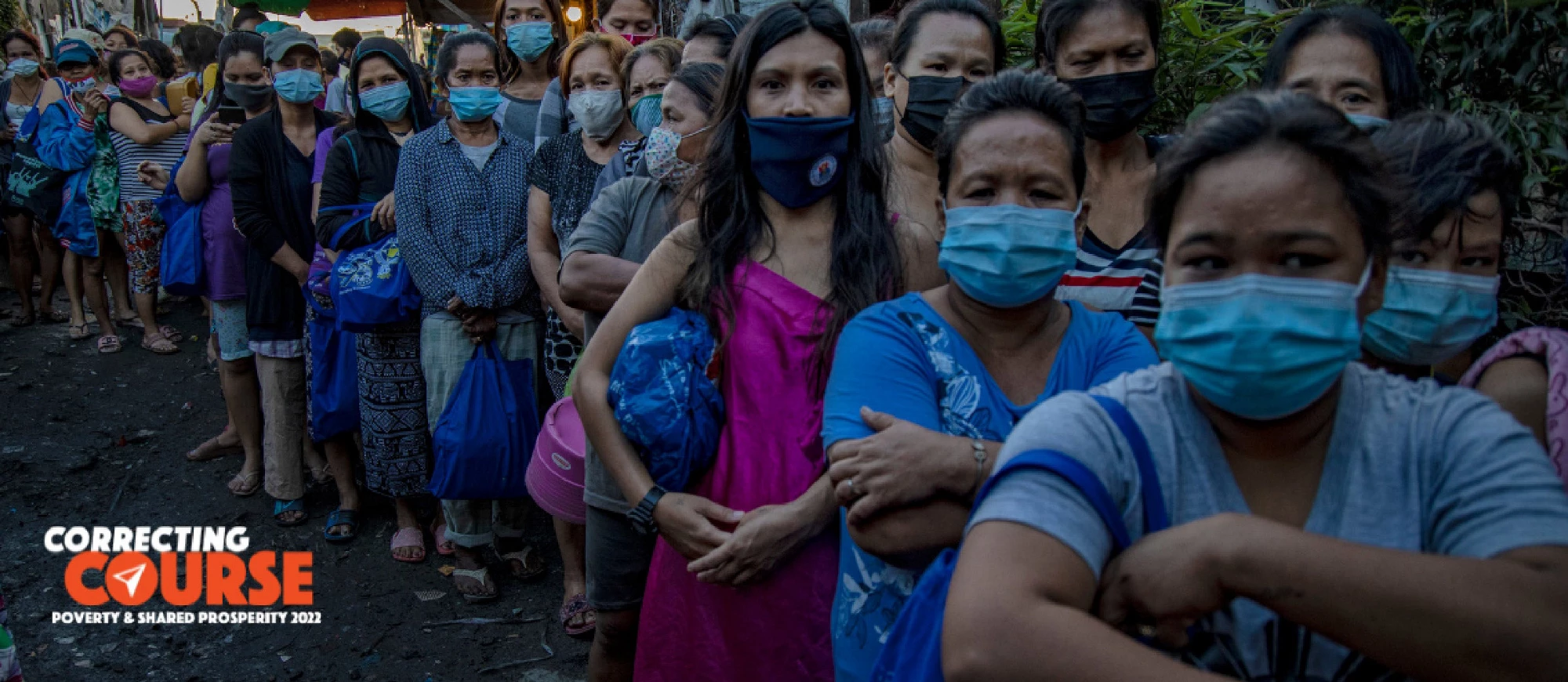 In 2020, the COVID-19 crisis caused the most significant setback to global poverty reduction in decades, with 71 million more people living in extreme poverty in that year compared to 2019. Photo source: EAP photo collection, Philippines, Ezra Acayan/World Bank
In 2020, the COVID-19 crisis caused the most significant setback to global poverty reduction in decades, with 71 million more people living in extreme poverty in that year compared to 2019. Photo source: EAP photo collection, Philippines, Ezra Acayan/World Bank
This is the first blog in a series about how countries can correct course and make progress in global poverty reduction. For more information on the topic, read the 2022 Poverty and Shared Prosperity Report.
In 2020, the COVID-19 crisis caused the most significant setback to global poverty reduction in decades, with 71 million more people living in extreme poverty in that year compared to 2019 . But a closer look at poverty trends shows that there’s more to the story: progress in poverty reduction was already slowing before the pandemic hit.
Slowing progress
From 1990 to 2014, the world made astonishing progress in reducing extreme deprivation: more than one billion people moved out of extreme poverty. The global poverty rate declined by 1.1 percentage points a year on average, from 37.8 percent in 1990 to 11.2 percent in 2014 (Figure 1).
Figure 1: Global poverty at the US$2.15 poverty line, 1990-2019
Yet, in the period that followed, between 2014 and 2019, poverty reduction slowed to 0.6 percentage points a year — the slowest rate over the past three decades (Figure 2). Poverty fell on average by at least one percentage point per year in all the five-year spells preceding 2015 – except for the 1995-2000 period when the Asian financial crisis caused global poverty to increase for two years in a row (1996-1998). Mathematically, it is harder to keep up the pace of poverty reduction at lower poverty rates. However, this is not the root cause for the change in trend. The main reason for the slowdown is that extreme poverty is becoming increasingly concentrated in regions with lower per capita income growth.
Unequal progress
Two regions, East Asia and the Pacific and South Asia, accounted for most of the reduction in global poverty between 1990 and 2014. In East Asia and the Pacific, extreme poverty fell from 66 percent of the population in 1990 to 4 percent by 2014. In South Asia, poverty was reduced from 50 percent in 1990 to 18 percent in 2014. By 2014, these two regions accounted for a much smaller share of the global extreme poor. In contrast, poverty fell at a much slower rate in Sub-Saharan Africa: from 60 percent in 1990 to 38 percent in 2014.
Figure 2: Annualized change in the global poverty rate, by period
After 2014, South Asia was the only region with a considerable share of the global poor that continued with substantial poverty reduction. In the five years between 2014 to 2019, the region halved its extreme poverty rate to 9 percent. In Sub-Saharan Africa, as GDP growth slowed and the population continued growing fast, poverty fell by only three percentage points to 35 percent.
With that, the share of the global extreme poor living in Sub-Saharan Africa reached 60 percent in 2019 — 389 million of the 648 million people in extreme poverty globally. This is six times higher than the region’s share in 1990 — when the region accounted for only 13 percent of the total (Figure 3).
Figure 3: Regional distribution of the global poor, 1990 - 2019
What does this mean for the goal of ending extreme poverty globally?
These regional trends have important implications for our ability to reach the first Sustainable Development Goal of eradicating global poverty by 2030 or the World Bank Group’s target of reducing global extreme poverty to under three percent by 2030. The estimates beyond 2019 utilize data from Mahler ⓡ Yonzan ⓡ Lakner (2022) for 2020 and growth forecasts from the Global Economic Prospects for years 2021 to 2024 as described here. Beyond 2024, poverty is projected using each country’s historical average growth from the 2010-2019 period (see Poverty and Shared Prosperity Report 2022 for details).
We estimate that poverty will decline to less than three percent of the population in most regions by 2030 — although insufficient data make projections uncertain for the Middle East and North Africa. Yet, to reach such a target in Sub-Saharan Africa, each country in the region would need to grow at about eight times the average annual growth rates achieved between 2010 and 2019.
In a more realistic scenario, we expect 30 percent of the population in Sub-Saharan Africa to be still living in extreme poverty in 2030. This would bring global extreme poverty close to 7 percent in 2030, more than double the World Bank Group’s goal of 3 percent (Figure 4).
Figure 4: Projecting extreme poverty to 2030
Addressing fragility
One of the reasons for the high levels of poverty in Sub-Saharan Africa is the strong link between extreme poverty and a country’s fragile and conflict-affected status. Only 10 percent of the global population lives in fragile and conflict-affected areas, yet these countries are home to 40 percent of those living in extreme poverty.
Of the 46 African countries with available data for global poverty monitoring, 19 are affected by conflict and fragility, according to 2019 data. These include the most populous country in the region, Nigeria, which has seen little progress in poverty reduction over the decade leading up to the pandemic, and the second poorest country in the region, the Democratic Republic of Congo, where more than half of the population lived in extreme poverty in 2019.
Fragility also contributed to rising poverty in the Middle East and North Africa. Extreme poverty rates are still relatively low there, but it is the only region where poverty levels have been increasing since 2014, driven mostly by the situation in fragile and conflict-affected economies. The latest data for the region shows the extreme poverty rate at 7.5 percent, three times higher than in 2014. However, the estimates for the Middle East and North Africa are subject to a great degree of uncertainty. Due to the lack of recent survey data for some countries, data coverage in the region fell below 50 percent in 2019, preventing a regional poverty estimate from being published. The latest data are from 2018.
As we live through a time of uneven post-COVID-19 economic recovery and other crises, timely and accurate data to measure progress on extreme poverty reduction will be crucial. Improvements in data availability have taken place in several parts of Sub-Saharan Africa, especially in West Africa. Yet critical gaps persist in others, such as East and Southern Africa. As poverty remains increasingly concentrated in countries impacted by conflict and fragility, which makes using traditional data-collection methods more challenging, this issue is poised to affect the monitoring of global poverty throughout this decade.
The authors gratefully acknowledge financial support from the UK Government through the Data and Evidence for Tackling Extreme Poverty (DEEP) Research Program.





Join the Conversation